|
Market Square
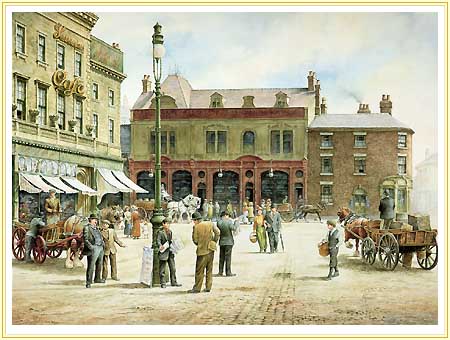
Market Square - 1912
The
busy streets in the Potteries town of Hanley hears the
newsvendor's cry - "Final, City Final" - trade is brisk with
dramatic headlines repeated in every conversation. Titanic sunk two
miles deep!
1912 Hanley
news vendor's cry "The Titanic has Sunk" The Staffordshire town
where captain Smith was born.
This picture (by
Anthony Forster) is painted with Pidduck's Jewellers behind. On the
left is Swinertons Cafe and the indoor market. At the top of the
picture are two public houses The Angel and The Grapes in Town Road.
(was High Street)
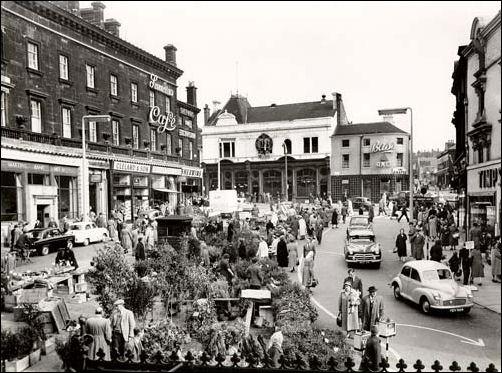
Market Square
1960-61
A similar scene to a present market day in Hanley's Market Square.
The large building (indoor market) on the left housed Swynerton's Café and
Sherwin's music store was demolished to make way for the Potteries
Shopping Centre in 1980.
The buildings in the background are The Angel Hotel and the Grapes,
advertising 'Bass only'.
© Staffordshire
Past-track
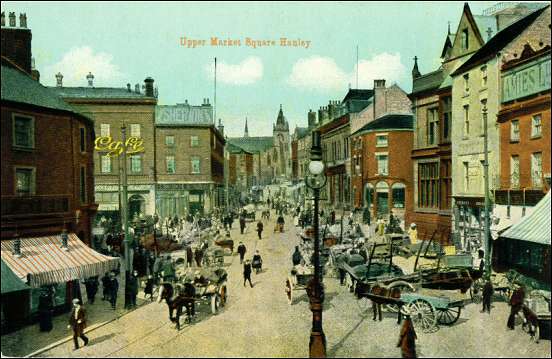
Upper Market
Square, Hanley
| This view is just at the end
of Parliament Row - to the left (just in front of Swinertons
cafe is Market Square.
When Market Square was full the traders set up stall in Upper
Market Square which was at the junction with Market Street
(Parliament Row). Goods were sold from the back of horse-drawn
carts.
AMIES shop sold 'Society
Boots' and next door was Williams & Bedworth, auctioneers, by
1912 the auctioneers building was turned into The Lyric
Electric Theatre - showing silent films (this closed by 1930).
The lack of cars dates this
picture at the beginning of the 1900's. Note the tram lines
running from the bottom left up Town Road towards St. John's
Church. |
The
Angel Restaurant:
In
1893: Messrs. Alfred Chew and Co., Wholesale and Family Wine and
Spirit Merchants,
13, Market Street, Hanley.......

13, Market Street,
Hanley
Angel Restaurant & Wine Stores 1893
Alfred Chew and Co
founded in Hanley in 1887. The Head office was at the Angel, Market
Street, Hanley.
By 1893 they had branches in Burslem, Fenton, Longton, Birmingham
(three branches), Aston, Nottingham, Derby and Coventry.
Scotch whisky was
21shilings per gallon and Kineraig cigars at 42shilings per dozen.
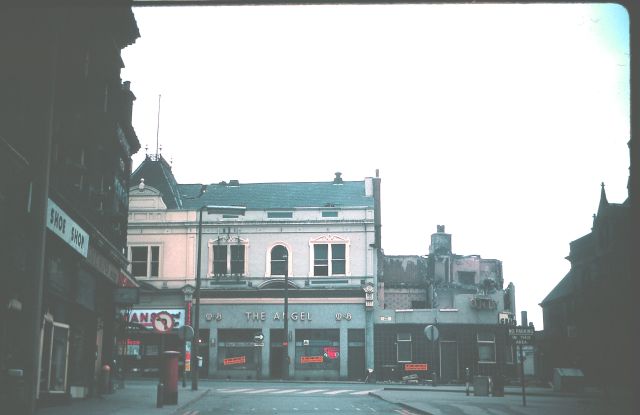
The Angel
Restaurant in the 1970's
In the 1890's the
Angel Restaurant "a handsomely fitted up establishment, where
luncheons, dinners, suppers and all refreshments are served in
first-class style.
Part
of the Angel Vaults is still standing today and is used by The Abbey
National Building Society.
In
1893: Messrs. Gilman and Cooke, Clothiers and Outfitters, Market
Square, Hanley
 |
"In a district like that which
surrounds Hanley, there are naturally many diverse classes to be
catered for, and through the operations of the firm Messrs.
Gilman and Cooke, both the middle and working class population
have an opportunity that might otherwise be lacking...."
"Being a corner shop the
establishment possesses the advantage of frontage to the High
Street as well as to Market Square.... The premises is in the
very heart of the town and the centre of its commercial life..."
|
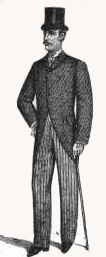
|
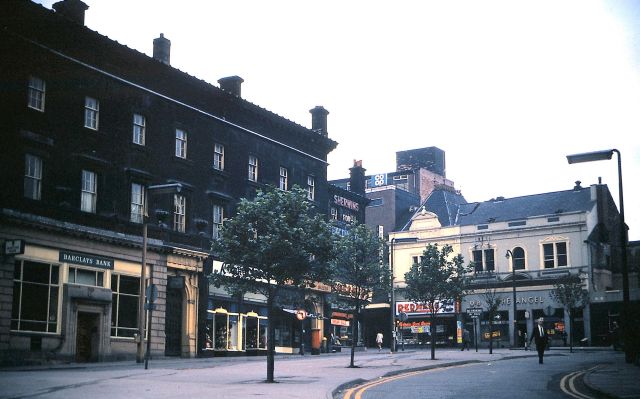
Hanley Indoor Market
- photo taken on a quiet Sunday, from Market Square
The whole of the
market area was demolished to make way for the Potteries Shopping Centre
Since 1776 Hanley had had full market rights
and the indoor market hall, in a 'classical style with Doric columns', the
market hall was opened in 1849 on the site of the former Swan Inn.
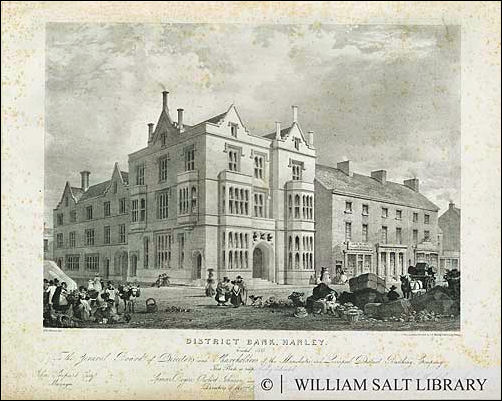
'District Bank, Hanley.
Erected, 1833.'
Showing a Gothic building and other
houses/shops in the street.
There are people in the street outside the bank, selling their wares.
© William Salt Library
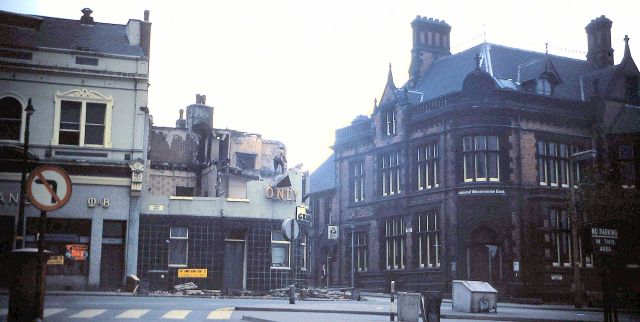
1970's - National Westminster Bank
- now replaced with a modern building -
The Grapes public house in the process of
being demolished.
Pidduck & Son, jewellers:
At the bottom of
Market Square and by the junction with Fountain Square was Pidduck &
Sons - a famous Hanley jewellers. Their shop first opened in 1841,
was refurbished in the 1920's and rebuilt in the 1980's.
Henry Pidduck was
the mayor of Hanley in 1864
The Blue Riband is the award
received by the ship with the record for the fastest transatlantic
crossing it was designed by Henry Pidduck & Sons Ltd.
The Blue Riband was a creation of the transatlantic shipping
companies in the 1860s, for the publicity opportunities of
possessing the fastest ship. It was represented by a blue pennant
flown from the topmast of the ship, until 1935 when Sir Harold
Keates Hales (1868-1942), a British politician and owner of Hales
Brothers shipping company, initiated a trophy.
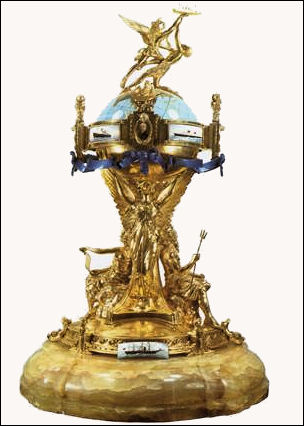
The Blue Riband -
Hales Trophy
In 1933, Hales commissioned the
trophy to be designed by Henry Pidduck & Sons Ltd., silversmiths of
Hanley, Stoke-on-Trent.
The Hales Trophy is made of solid
silver and heavy gilt, and stands almost four feet tall, weighs
nearly 100 pounds and cost $4,000 to create. The trophy consists of
a globe resting on two winged figures if Victory sanding on a base
of carved green onyx. An enamelled blue ribbon surrounds the middle
of the prize.
The award is decorated with models
of old galleons, modern ocean liners and statues of Neptune and
Amphitrite, god and goddess of the sea. The trophy is surmounted by
a figure depicting Speed pushing a three-stacked liner against a
figure symbolizing the forces of the Atlantic. The Atlantic Ocean is
represented in blue enamel with the traditional ocean liner route
indicated by a red enamelled line.
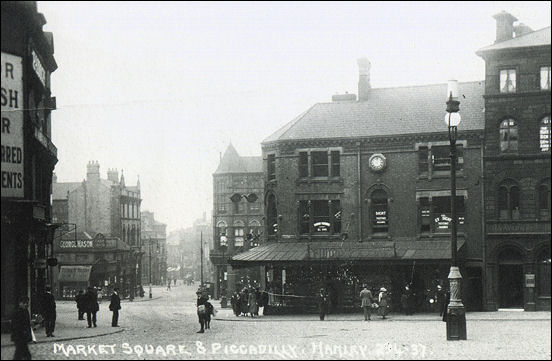
A view
from Market Square looking down to the left through Fountain Square
and Crown Bank to Piccadilly. Pidduck's is in the centre of the
picture, the clock on the front of the building was famous as a
meeting place.
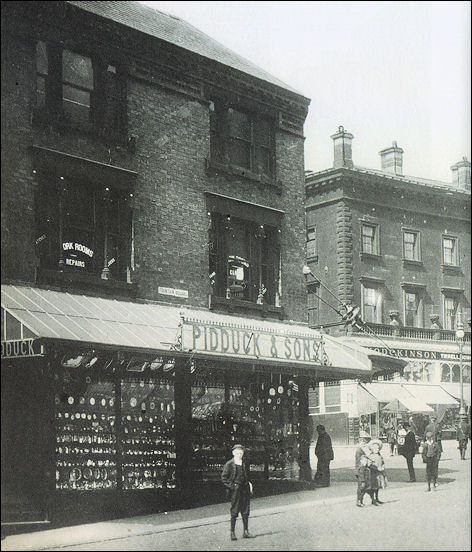
A view from Fountain
Square looking into Market Square. To the right is the building of
Hanley Indoor Market.
To the left is Pidduck
& Sons - the main entrance and frontage was in Market Square.
|
![]()
![]()
![]()